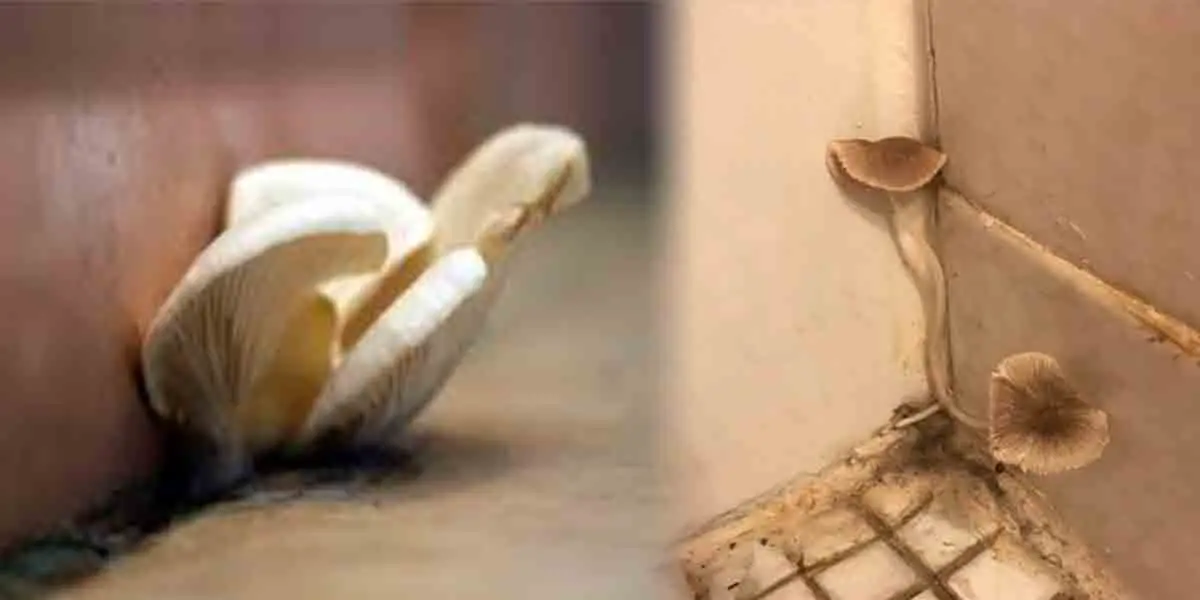Do you find it unpleasant and confusing to see mushrooms growing in bathroom? I do.
Mushrooms love moisture. And your bathroom is usually by far the highest regular humidity in your home. According to Bupa, Mushrooms are made up of roughly 92% of water. They are basically the fruit of the fungus that grows rapidly in the presence of moisture and humidity. Pretty gross.
A bathroom is a hotspot for moisture and humidity, so mushrooms growing in a bathroom can be common.
You might have heard mushrooms prefer to grow in the ground, but that’s not true for all cases. It takes very little medium for some fungus to grow. This is how you may find yourself looking at these tiny mushrooms in your bathroom.
The tiny fungus spores present in decaying logs or wood, which are likely invisible, act as the root system that helps mushrooms to grow. These spores are so tiny that you’ll need a microscope to see them.
Mushrooms require high humidity and low light as their environmental condition to grow. And a bathroom is a suitable spot for it.
The primary reason for mushrooms growing in a bathroom is likely a plumbing leak that is keeping the area damp. This allows your subfloor, drywall or wooden stud framing to host fungal spores that support the growth of mushrooms.
Nobody wants to see these in their bathroom, or anywhere in their home. Taking charge and removing the cause and the mushrooms themselves will be priority number one!
Before diving into the possible solution to prevent mushrooms from growing in the bathroom, let’s take a look at why necessary to remove them?
Are Mushrooms Growing In a Bathroom Dangerous?
In short, yes, mushrooms growing in a bathroom indicate a potentially dangerous environment. But the fungi themselves are typically not harmful. There’s no need for immediate alarm. However if this issue isn’t addressed promptly, it can lead to various health implications such as respiratory issues and allergic reactions. The condition might also foster mold growth, posing a more serious health threat and damage to your home.
Frequently you’ll encounter species such as Cup mushrooms, also known as domicile cup fungus in your bathroom. These fungi thrive in humid environments and commonly establish themselves on materials like drywall, plasterboard, and rotten wood – all perfect breeding grounds for various fungal spores, including the potentially hazardous Aspergillus and Stachybotrys chartarum or “black mold.”

According to Hunker, Cup mushrooms can be dangerous and need to be removed as soon as possible to prevent children or pets from accidentally ingesting them.
Also, If this is not taken care of at an earlier stage, then it could lead to mold infestations (causing health problems like allergies, asthma, bleeding lungs, breathing difficulties, and more).
If you spot mushrooms or signs of other fungal growth in your bathroom, immediate remediation is necessary. Eradicating these unwanted growths is the first step. Ensuring they don’t return is equally important. Identifying and rectifying the root cause of the mushroom growth – typically excessive moisture or damp conditions – is the key to maintaining a safe, fungus-free bathroom environment.
Most Common Types of Fungi Found Indoors
Sure, here’s the requested table in markdown format. The structure of the table is as follows: two columns for the Fungal Spores/Mushrooms name and Description, and a third blank column for your Photos:
| Fungal Spores/Mushrooms | Description |
|---|---|
| Cup Mushrooms (Peziza domiciliana) | Often found in damp areas of homes, especially bathrooms |
| Aspergillus | A common indoor mold, can produce spores causing health problems in individuals with compromised immune systems |
| Penicillium | Known for its strong smell and often found on water-damaged materials. Some species can produce mycotoxins |
| Stachybotrys chartarum (Black Mold) | Known as toxic black mold, it produces mycotoxins that can cause health issues |
| Cladosporium | Commonly found on damp building materials and in HVAC systems. It is often a black or green color |
| Alternaria | A very common mold that is often found in damp places indoors, such as under leaky sinks or in showers |
| Fusarium | Grows in damp areas and can cause infections, especially in people with weakened immune systems |
| Trichoderma | Commonly found on damp carpet, wallpaper, and other wet surfaces. Some species produce mycotoxins |
| Mucor | Grows quickly in thick patches in damp areas. Can cause health problems, especially in people with weakened immune systems |
| Chaetomium | Has a cotton-like texture and usually grows on water-damaged drywall |
What Causes Mushroom to Grow In A Bathroom?
As discussed earlier, the primary reason that causes mushrooms to grow in a bathroom is moisture. In a bathroom, the air holds a lot of moisture because of the bathing, while the room also contains a lot of wet surfaces such as walls, doors, and floors.
You might have observed; even if you cut down a mushroom, the next day, another mushroom grows from the same place because of the microscopic fungal spores present on the surface.
These spores are so tiny and lightweight that they can get easily carried to various places in your bathroom by the wind. As a result, these fungal spores get deposited at different places such as drywall, door, bathtub, walls, floors, etc.
With the support of moisture, these fungal spores produce their fruit, which we refer to as mushrooms.
Now, you can agree to the fact that bathrooms deliver the suitable environmental condition for a mushroom to flourish. It needs an environment having high humidity, low light, and a damp surface.
Therefore, only cutting down the mushroom won’t solve this issue. The big question is how we can prevent mushrooms from thriving often? Is there any permanent solution? Let’s take a look at them.
How to Prevent Mushroom Growing In A Bathroom?
Physically Remove Mushroom
The first thing you should do is physically remove mushrooms and clean the area with bleach water.
You can prepare a bleach solution by adding 1 cup of bleach into 1 gallon of water inside a spray bottle. And spray the entire surface thoroughly. If the surface is rough, take a stiff brush and rub it back and forth.
Only cleaning the surface with bleach water won’t solve this problem. It might happen to see mushrooms returning after a while.
Therefore, after a basic bleach wash, you must disinfect the area with a powerful disinfectant or fungicide.
Disinfect the Area
Disinfecting the affected surface with a powerful disinfectant is necessary to prevent mushrooms from growing.
The one with benzalkonium chloride is much recommended, it kills the fungal spore, which is the root cause of seeing mushrooms.
Along with fungal spores, benzalkonium chloride is capable of eliminating bacteria, yeasts, and viruses. Inhibiting their future growth.
It is recommended to use BenzaRid EPA registered disinfectant that can kill toxic molds, including fungal spores.
Whether your bathroom has a porous or non-porous surface (including metals, hard plastics, wood, and tile), this disinfectant is suitable for all.
Take the undiluted solution, spray 6-8 inches from the surface, and then rub with a sponge or cloth. Make sure you’re wearing a mask to avoid inhaling while applying the solution.
Replace Drywall & Wood
If your bathroom’s drywall is exposed to water for too long, then it can get damaged by moisture. Not taking care may lead to weak and soft drywalls, which again lead to fungal growth and mold build-up.
Most of the bathroom interiors use the standard gypsum board as their drywall. Gypsum boards hold moisture content up to 5 percent, which is quite low. However, there is a much better option to replace with, if you’re planning.
Greenboard drywall panel is one of the best alternatives to go with. It is more durable and a little expensive than a standard gypsum board, giving you a thicker coating of paper that is protected by wax for water resistance.
Fix Source of Dampness
When your bathroom is ideal, it should not remain wet always. If you notice dampness in your bathroom even after leaving it for hours, then it could be a problem of leakage.
There might be certain faucets or bathtubs with broken seals that are leaking. Another reason for dampness could be too much condensation.
When humid air comes in contact with a cold surface forms water droplets. This often occurs after taking a hot shower, causing water droplets to remain in the air.
Too much condensation could mean dripping water along your bathroom’s surfaces.
Therefore, properly maintaining ventilation in your bathroom is essential to avoid mold or mushroom buildup.
One of the most cost-effective ways is leaving your doors and windows open, especially just after taking a bath or shower.
However, you should consider installing a ventilation fan on your wall or ceiling because it effectively handles moisture-related problems by eliminating foggy windows, steamy mirrors, wet walls, etc.
With this, let’s see how you can add better air circulation in your bath space.
Ventilate Your Bathroom
If you observe too much humidity and moisture in your bathroom, it will be effective to install a ventilation fan.
When humid air is present in your bathroom, it makes the surface damp, attracting mold and mildew to form.
A ventilation fan is much powerful and can remove smoke, odors, fumes, and most importantly moisture, which is the main reason for mushrooms to grow in a bathroom. It brings fresh air, maintaining a proper airflow in your bath space.
What happens if you just don’t have a bathroom fan for ventilation? I’ve covered this here, with my 5 alternatives to a bathroom exhaust fan.
FAQs: Mushrooms Growing In Bathroom
Are mushrooms growing in your bathroom edible?
It is highly advised not to eat mushrooms growing in your bathroom because the one you see is a result of humid air and moisture problems. This increases the chances of black mold called stachybotrys chartarum making it highly toxic to eat.
Will bleach kill mushroom spores?
Yes, bleach can effectively kill mushroom spores. It’s commonly used as a disinfectant due to its ability to destroy bacteria, viruses, and fungi. However, you should be careful while using bleach as it is a strong chemical that can cause damage to some materials and surfaces.
Will vinegar kill mushroom spores?
Yes, vinegar can kill mushroom spores due to its high acidity levels. Vinegar is a safer alternative to bleach and other strong chemical cleaners. You can make a mixture of equal parts vinegar and water for a homemade fungus-destroying solution.
Does alcohol kill mushroom spores?
Yes, alcohol can kill mushroom spores. Isopropyl alcohol (rubbing alcohol) is often used to sterilize areas and prevent the spread of spores. However, it should be used with caution, as it is flammable and can be damaging to certain surfaces.
Conclusion
I hope this post helped you in getting an idea, why mushrooms grow and the risks they can present.
Should you stumble upon a mushroom sprouting from a corner of your bathroom, don’t let panic take hold. Stay calm and put into action the necessary measures to inhibit its further growth.
Your primary aim should be to reduce moisture levels and ensure adequate ventilation within your bathroom.
If you feel unsure about handling the situation yourself, there’s no harm in reaching out to local housekeeping or professional cleaning services. They’re equipped with the necessary tools and expertise to deal with such situations. Remember, it’s always better to be safe than sorry!




